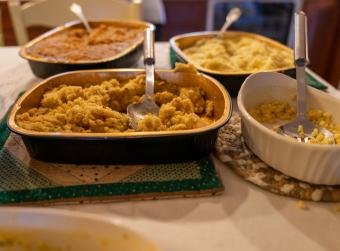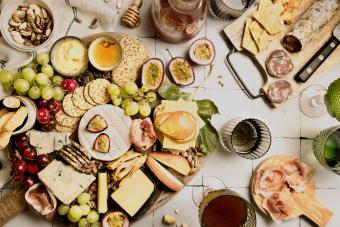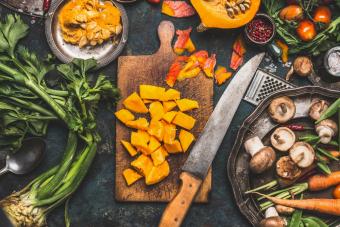
Ever followed a recipe that other people rave about, only to have it come out tasting meh? Same! That's because it's not necessarily the ingredients that lack flavor, but rather the failure to use cooking techniques that build flavor. So if your cooking only gets okay reviews, try these simple tricks to go from OK to OMG every time you enter the kitchen.
Brown Food Tastes Good

Browning protein and veggie ingredients until they get a nice, caramelized crust adds a TON of flavor to foods. When you're in a hurry, it's often a challenge to find the patience to allow the foods to develop that flavorful browning — but it only adds a few minutes more to your cook time, and there's nothing extra that you have to do.
Here's how to handle it. When you put your protein or veggies in a hot pan to cook (or on the grill), allow them to sit in contact with the pan for 4-5 minutes without stirring or moving them around. This allows plenty of heat contact that browns the food and adds all that flavor. After 4-5 minutes, stir or flip the food and resist moving it again for 3-5 minutes, so it browns on the other side, too. Then, add other ingredients and stir away to your heart's content.
If you're cooking food in the slow cooker or pressure cooker, brown it before you add it to the crock for much better flavor.
Browning food in this way creates flavor through the Maillard reaction, which is a reaction between the food's aminno acids and sugars that develops deep umami notes.
Don't Overcrowd the Pan

Overcrowded pans are where flavor goes to die. So whether you're frying pork chops, cooking up breakfast sausage, making soup, or whipping up a stir-fry, whatever you do, don't overcrowd your pan. If this means you have to cook in batches (meats first, followed by veggies, followed by sauce), then it's worth the extra time to do it. That's because when you overcrowd a pan, you wind up steaming the food instead of allowing it to sear and get that flavorful Maillard reaction we just talked about.
Cook in batches to make chili, soup, or stew for a HUGE flavor difference. Brown meats first in a little fat. Remove the meat from the fat in the pan with a slotted spoon & set it aside. Add in veggies and cook them in the oil until they brown. Finally, add the meat back and all other ingredients to make a flavorful chili, soup, or stew.
Deglaze to Add More Flavor

When you're browning foods in a pot or pan, the browned bits of the food stick to the bottom of the pan when you remove the other food. That's a ton of flavor that gets left in the bottom of the pan that should be going into your mouth and hitting your taste buds. Deglazing is a simple trick that gathers up all that flavor to re-add it to your food, where it belongs.
If you're making a soup, stew, or stir-fry, and you're ready to add the remaining ingredients, add a liquid ingredient (white wine, broth, water, vinegar, tomatoes in juice) to the hot pan and use the side of a wooden spoon to scrape the browned bits off the bottom of the pan. All that flavor goes right back into your soup, stew, or stir-fry.
If you're frying protein, such as pork chops, chicken, seafood, or steak, make a pan sauce. Remove the protein from the pan and set it aside on a platter to rest, tented with foil. Deglaze the pan with some liquid (broth, vinegar, white wine), scrape up the browned bits with the side of a spoon, add some seasoning or herbs (chopped shallot, dried thyme, citrus zest, black pepper, etc.), and let it simmer until it reduces by about half. Then, whisk in a few pieces of very cold butter one at a time, and you've got a yummy pan sauce to spoon over your protein, returning all that good flavor from the pan to your food. Bam! Instant palatability.
Always Salt Pasta Water

Many people try to minimize salt intake by skipping the salt in pasta water. This always leaves the pasta tasting flat and less palatable. For most things you cook where you drain the water off afterward (think water for boiling potatoes, pasta, etc.), it should be nicely salty so the flavor develops quickly. Most of the sodium will drain away when you drain the water, but a small amount (about 2%) remains, adding dimension and flavor to the pasta (or whatever else you're boiling) for a tastier dish.
Taste and Adjust Seasonings

Before you serve your food, always give it a tiny taste and adjust your salt and pepper. While you should use seasoning while you cook, a quick taste at the end (followed by a second or third taste as you adjust) will make sure your seasoning level is just right.
For hygiene purposes, use tasting spoons instead of the spoon you're cooking with. Use one spoon per taste, and always taste with a clean spoon.
Don't Skip the Salt

If you're watching your sodium intake, the inclination is to skip salt altogether. The thing is, you don't have to salt for saltiness — and in most homemade foods, salt is there to make the natural flavors in the dish shine. Without a small amount of salt, the dish will taste flat. So you don't need to add a ton of salt and make foods salty, but adding a little can help everything taste a whole lot better.
Use Fresh Herbs When You Can

Fresh herbs add flavor and a bright freshness to any dish. While you typically add dried herbs at the start of cooking, stir in many chopped, fresh herbs right at the end of cooking to preserve the flavor. This includes most leafy herbs, like basil, parsley, chives, cilantro, oregano, and chervil. Woody herbs, like thyme and rosemary, can be added when you'd normally add dried herbs in order to give the flavors and aromas time to integrate and develop in the dish.
Opt for Local, in-Season Ingredients

Fresh, in-season ingredients almost always taste better than out-of-season, frozen, canned ingredients or non-local ingredients that have had to endure long shipping and lots of refrigeration. So when possible, cook foods that are in-season with ingredients you can access locally after they've been freshly harvested. Your food will taste so much better.
A Little Fat Adds a Lot of Flavor

When in doubt, always remember that fat adds flavor. And it doesn't need to be a ton of fat. Opt for minimally processed fats like butter, EVOO, or rendered bacon fat over seed oils or highly processed fats. If you're making a sauce, stir in a few pats of butter at the end or drizzle a little olive oil on steamed veggies.
Sauce Is Life

Add sauces to plain foods like a cooked hunk of meat, plain rice, or steamed veggies. You have so many sauce options, from a quick pan sauce to an easy-to-mix pesto to a fast aioli that'll bring your food together in amazing ways.
Related: 11 of My Favorite Quick Sauce Recipes to Hack Weeknight Dinner
Don't Skip the Aromatics

Aromatics — in many dishes, such as mirepoix made from celery, carrots, and onions — serve as the base of many stews, soups, and sauces for a reason: they add tremendous flavor. So never skip these ingredients in recipes, and brown them like you would all your other veggies to develop out-of-this-world flavor.
Sign up for our newsletter featuring all the latest stories and products we love.
We Eat With Our Eyes

Sure, we're talking about taste here, but presentation matters, too. Before you ever eat with your mouth, you eat with your eyes (there's actually science to back this up), so presenting food in pretty ways can make it taste better. You don't need to be all cheffy or anything, but try to make a pretty, colorful plate of food that looks as delicious as it tastes.
Add Texture

The enjoyment of food is about more than flavor. It's also about temperature and texture. So when you're making foods, try to add textural and temperature elements to your main dish, such as adding crunchy croutons to a smooth, creamy soup or adding a smooth sauce to al dente pasta. Find ways on your plate to switch up the texture to make all elements taste better.
Doubtful that texture and temp matter? Think about the perfect grilled cheese. Yes — it tastes fab, but the textures add so much to the experience — toasted bread that's crunchy on the outside and soft on the inside, combined with gooey cheese? It doesn't get much better than that. Or consider pad Thai — soft noodles with cooked veggies topped with cool, crispy fresh bean sprouts and crunchy chopped peanuts. It's a temperature and texture sensation that's addictive.
Salt Raw Eggplant & Zucchini to Remove Bitterness

Watery veg like eggplant and zucchini actually have bitter juices inside that can impart off flavors. To remove this bitterness, slice the veggies and layer them in a colander, sprinkling liberally with salt (before cooking). Allow it to sit over a bowl or the sink for 20 minutes. The juices will drain. Wipe the excess salt off the vegetables with a paper towel. Don't worry — most of the salt goes down the drain, so nothing will taste salty as long as you wipe it all off, but the food will taste so much better.
Good Food Is the Spice of Life

You can turn your cooking from just OK to absolutely amazing with minimal effort. By following these hacks, you'll be serving up tasty food that'll leave everyone wanting seconds.







